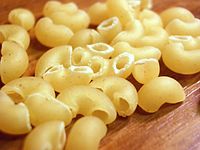
Photo from wikipedia
Glucosinolate hydrolysis products are responsible for the health-promoting properties of Brassica vegetables. The impact of domestic cooking on the myrosinase stability, glucosinolates and hydrolysis products in 18 cabbage accession was… Click to show full abstract
Glucosinolate hydrolysis products are responsible for the health-promoting properties of Brassica vegetables. The impact of domestic cooking on the myrosinase stability, glucosinolates and hydrolysis products in 18 cabbage accession was investigated. Cabbages were steamed, microwaved, and stir-fried before analysis. Cooking significantly affected myrosinase stability and glucosinolate concentrations within and between cabbage morphotypes. Myrosinase was most stable after stir-frying, with up to 65% residual activity. Steaming and microwaving resulted in over 90% loss of myrosinase activity in some accessions. Stir-frying resulted in the greatest decrease in glucosinolate concentration, resulting in up to 70% loss. Steamed cabbages retained the highest glucosinolates after cooking (up to 97%). The profile and abundance of glucosinolate hydrolysis products detected varied across all cooking methods studied. Cooking reduced the amounts of nitriles and epithionitriles formed compared to raw samples. Steaming led to a significant increase in the concentration of beneficial isothiocyanates present in the cabbage and a significantly lower level of nitriles compared to other samples. Microwaving led to a reduction in the concentrations of both nitriles and isothiocyanates when compared to other cooking methods and raw cabbage. The results obtained help provide information on the optimal cooking methods for cabbage, suggesting that steaming may be the best approach to maximising beneficial isothiocyanate production.
Journal Title: Foods
Year Published: 2021
Link to full text (if available)
Share on Social Media: Sign Up to like & get
recommendations!